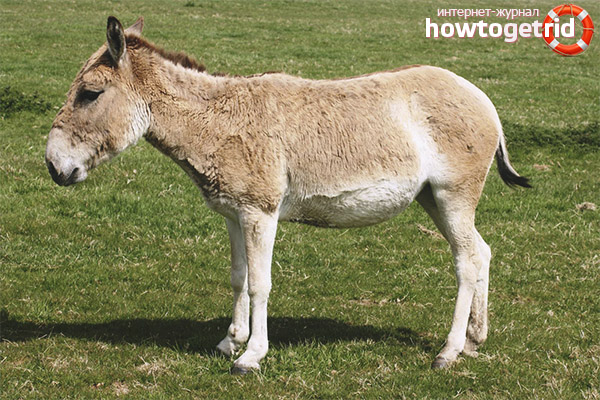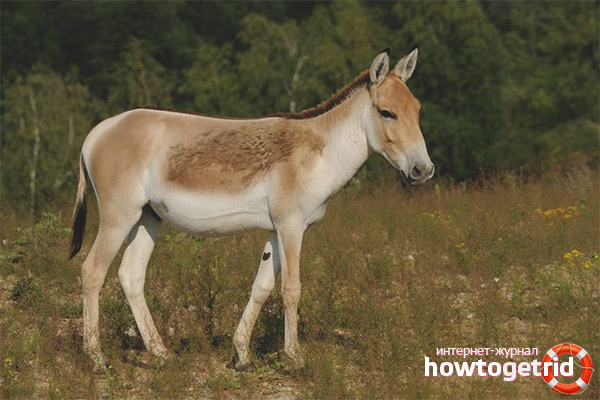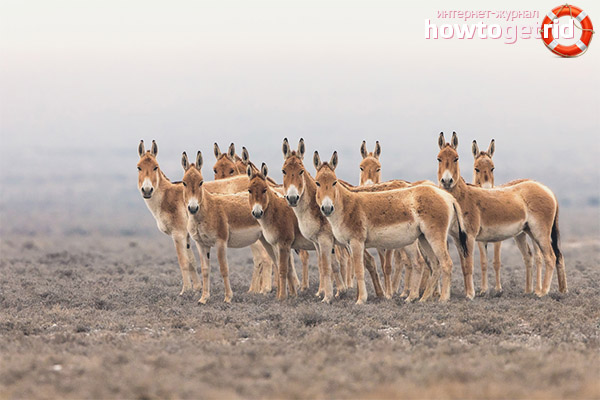The content of the article
Kulans belong to the category of animals that delight with their special beauty and unusual color, graceful rapid running, the ability to relax for a long time, without lying on the ground. They have relatives, and above all these are zebras, donkeys and wild horses, that is, those who belong to the equine mammals of the equine family.
The kulan is often called a djigetai - this is the Mongolian version of the name of the animal. And due to the fact that it has a lot in common both from a horse and from a donkey, many call it a semi-donkey. But he is not amenable to training, in contrast to donkeys, which still benefit people.
Description of appearance
The length of the body is from 170 to 200 cm. The height at the withers is on average 120 to 125 cm. The weight of adult kulans can be from 120 kg, especially large to 300 kg, and in this it differs from a domestic donkey in much larger sizes. And when compared with a domestic horse, it loses much because of the smaller size of the head and shorter ears: they have long kulans - from 17 to 25 cm. But kulans have narrower legs and longer hooves.
These animals have a mane, starting at the withers and ending near the ears. It is short and always stands straight. But the bangs, like a fellow horse, are absent altogether. The muzzle is elongated, eyes wide apart.
In the summer season, when it’s hot, the fur of these animals is short, tight-fitting. When the cold comes, it becomes long, twisting a little so that the kulan does not freeze. Mother Nature took great care of these animals, presenting such a coat and in such a way the circulatory system that animals are not afraid of cataclysms of cold or hot pores.
The color of the kulan can always be seen, since its upper body, head and neck are sandy in color, and it can be of various shades, or red-brown. Those individuals that live in the foothill zones have a more pronounced color, and they are smaller compared to the plains - higher and very similar in appearance to horses.
The trunk in the lower part, the inner zones of the legs, the para-caudal part have a white tint. Contrasting are the mane and the tips of the ears - dark brown in color. A dark narrow strip passes along the midline of the back, which then passes to the tail. The tail can be completely dark or with a brown tint, it is short - no more than 40 cm and thin, but it seems more voluminous due to a bundle of long hair and a black brush.
It is difficult to distinguish males and females by their appearance; sexual deformism is almost not expressed in this species of equids, females are always smaller.
Kulans have very strong limbs, so animals can run without stopping for a very long time. And with a speed exceeding 65 km / h. And even a baby who was born three to four days ago does not lag behind his parents, developing agility amazing for such an age - up to 40 km / h. Speed running and great stamina allow you to escape from less agile predators. Kulans differ in that they jump beautifully. If necessary, they can overcome a height of 1.5 m easily and gracefully, and also effortlessly jump from a 3-meter surface. Kulans, except for sick and old individuals, are always in excellent physical shape, active and energetic.
Habitat areas
Previously, these animals lived in the Ukrainian steppes, in the northern regions of the Caucasus, on the virgin expanses of Kazakhstan, Turkmenistan, and Uzbekistan, but now populations are declining, as human land is gradually being plowed, and the virgin steppes are becoming smaller.
The kulan was preserved only because it is protected by people who are not indifferent to nature, by strict protection.Nature reserves are being created for them and other endangered species, and outside their territories it is almost impossible to see dzhigetai.
If you really want to admire these animals, you should go to the southern regions of Transbaikalia or Western Siberia, Mongolia or Iran, Afghanistan or China, where there are dry flat deserts or semi-deserts, numerous hilly areas, but not where sandstone occupies a large area. The kulan lives at an altitude of 300 - 600 m above the sea surface.
Lifestyle
Kulans are herd animals. They can live in a community of 5 to 25 goals. They can rest in a lying position for no more than two hours, in winter much less, on average 30 minutes, and the rest of the time, if they are not busy looking for food and drink, they sleep peacefully until 8 o’clock.
The leader is usually located a little away from everyone, also eats separately, but still constantly monitors the area - suddenly there will be enemies or other danger. The whole herd always knows that it is under reliable protection, and in case of alarm their leader will warn everyone with a cry that is very reminiscent of the sounds made by a donkey. Everyone reacts to a danger signal instantly, even kids, very quickly breaking off, developing high speed, deftly jumping over obstacles.
If the leader does not get caught by the predator or does not fall ill, he will be able to manage the herd up to 10 years. Then a younger and stronger one may appear who wishes to become a leader. Having shown his fighting qualities and strength, he becomes a recognized leader. The old leader is waiting for a sad fate: the herd, which he so devotedly served, chases him away.
Enemies

Wolves are a significant danger to dzhigetaev. After all, they are also very hardy, and, having discovered a herd, they can pursue it for a long time until they can recapture the weakest animal. For kids, hyenas are a great danger. But mothers guard their offspring very vigilantly. If her child was attacked, then the mother-kulan will fight bravely, even if the forces are clearly unequal. She attacks with the help of her strong limbs - front or rear, and teeth are used. It is very difficult to resist such pressure. It has long been observed that Djigetai do not reconcile with dogs and sheep. These are the only animals to which they show aggression.
Food
Kulans eat mostly only herbal food, and therefore are common in treeless spaces. The diet of animals is not distinguished by delicacies, any greens are consumed, and when frost comes, they move to areas of little snow in search of saxaul or other preserved vegetation. The digestive system of the kulan is able to process even such plants that other animals bypass. This is due to the fact that it is difficult to obtain food in an area that is not rich in vegetation - both in winter and in the second half of summer, when the scorching rays of the sun can destroy the juicy grass.
However, the kulans themselves, without suspecting it, contribute to the fact that the grass cover, and therefore the food, is always in this stingy place. With their hooves, they endlessly loosen the soil, providing vegetation. But other representatives of the animal world also help them in this: other ungulates, rodents, insects. As practice shows, without them alone weeds can grow on the soil.
Due to the small amount of water in the habitat zone, kulans learned to drink any water, even if it is very salty or bitter. Often, in search of moisture, a herd can walk up to 40 km.
Marriage battles and procreation
Kulans very calmly behave in a herd, not showing any aggression towards each other and other animals. They even allow birds, most often jackdaws, to pull out their hairs, from which reliable and durable nests are obtained.
But in the period from May to August, where the meekness and quiet disposition go! To conquer the female, gentlemen arrange real bloody battles. At these moments, they turn into real uncontrollable monsters with bloodshot eyes and a grinning mouth. Their ears are pressed, they stand on their hind legs in front of each other, and then try to clasp an opponent with front limbs. Teeth are also used. Many males then suffer from wounds for a long time.
To attract the female, the leader, who until recently had not come close to the herd, is now very close. His actions are very interesting. To attract attention, he hooves the soil with his hooves, somersaults in the most dusty place. These manipulations mean that he wants to please the females. And they reciprocate, and this is manifested in the fact that the female gently nibbles the withers of the chosen one, which means she takes courtship and is ready for mating.
This method of feeding lasts for 10 months. During this time, accustoming to plant foods occurs gradually, so that the stomach learns to digest it. The kid has a lot of difficulties. Not only does he have to run away from predators along with everyone, but the young growth of 1–2 years old is already trying to offend the baby, and until his parents are far away, they strive to hurt him. However, the calm of the baby is guarded by adults.
Full puberty occurs only at the age of 4, and then mature males can claim leadership in the herd.
Video: kulan (Equus hemionus)












Submit